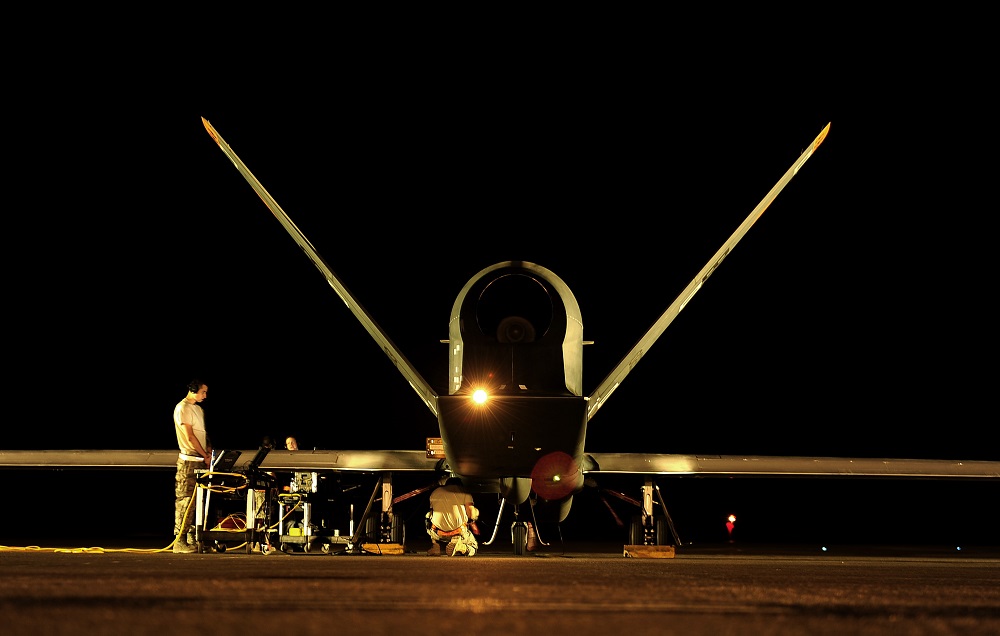In 21st century warfare, the rise of UAVs (Unmanned Aerial Vehicles) was not only a game-changer in terms of surveilling state enemies but also in killing them with no blowback to the aggressor. Increasingly, we are living in a world where the prevalence of technology such as UAVs is making it easier for the nation-state to fight a non-traditional war without having to put boots on the ground or pilots in the air. However, numerous ethical concerns remain including the ever-present risk of collateral damage, the generational legacy of these strikes, and the legal ramifications behind selecting targets.
It is my belief that drone strikes may be ethical in terms of limited usage against known terrorist or militia leaders but that they must also comply with international norms, which have to be agreed upon by all states who use drones for offensive military action. I believe that drone strikes should not be used as an offensive first resort unless capture of the enemy combatant is impossible or if the collateral damage of conducting a standard military operation is too high.
UAVs, or drones, can stay in the air from between eight to twelve hours continuously without needing to be refueled. They can maintain the element of surprise to strike targets without having their aerial location compromised. Being able to survey in detail a remote desert where enemy targets are gathered to a dense urban setting where leaders of a terrorist organization are meeting, the UAV is able to record at a high level of resolution what is going on anywhere in the world. For the state whether that is the United States, the United Kingdom, Israel, the drones are able to go and see where the average soldier or airman can’t go without risking life or limb for the mission.
Being able to strike enemy combatants in states, which are known terrorist havens, allows the U.S. and its allies to conduct kill operations without risking their own soldiers, airmen in countries where their physical presence would incite the local population. For some examples, Yemen, Somalia, and Pakistan are weak or failing states who have been host to terrorist organizations including al-Qaeda. Due to political constraints, The U.S. military is unable to eliminate the threat that these non-state actors pose through special forces raids, which is one reason why the U.S. has increasingly used drone strikes instead.
Drone use is perceived as less expensive, more effective, and less politically risky to political leaders who wish to forgo a risky raid or a bombing campaign by investing in targeted drones strikes instead to eliminate threats. For example, a U.S. Air Force airman can manually control a drone from over 7000 miles away in Nevada to strike a terrorist target in Northwest Pakistan just by pressing a few buttons.
Instead of having that same pilot fly his F-16 over Pakistan and risk being shot down or captured, the U.S. government and military are willing to use the UAVs for reasons of cost, effectiveness, and overall utility. The collateral damage of an F-16 versus an armed UAV should also be considered since an F-16 strike, especially in an urban area, is likely to cause a greater number of civilian casualties. Drone pilots can also help U.S. troops, for example, in being aware of enemy movements near them and guarding their positions, so as to prevent them from any surprises that could endanger their lives while operating in enemy territory.
Drone strikes may carry less collateral damage to civilian lives, but there will always be the chance for the loss of innocent life and families being destroyed. Whether that’s an errant missile crashing into a wedding party or a group of children running by a targeted building within seconds of a missile being launched and getting caught in the crossfire, death from the skies will not only affect terrorists but women and children too. Because drone strikes are less costly to governments and militaries, the rules of engagement can be abused to focus too often on low-level targets, who pose some threat but who could still be captured for intelligence purposes. A lack of international norms and standards regarding drone warfare leads to serious consequences in terms of possible abuse by governments who overuse it on secondary targets.
Airmen and women, who conducted drone strikes have suffered from Post-Traumatic Stress Disorder because they get to know their targets, see how they live, and struggle with having the power of death over them. High-resolution surveillance makes the act of killing personal despite the fact that these servicemen are thousands of miles away. When a drone strike goes wrong and innocent civilians are killed, it leaves a long-lasting psychological effect on the military personnel involved.
They may not see their victims when they are flying an F-16, but they are aware of what collateral damage is when they see the dead bodies of women, children being shown on the high definition screen. Military service members do not last long as drone pilots due to the immense mental strain placed on them especially when they did not sign-up for conducting warfare with a joystick. Alcoholism, depression, and family problems have occurred due to pilots being asked to conduct drone strikes in the name of national security.
Unfortunately, drone warfare may kill current enemies only to create more of them in the future. A son or daughter who see their father or mother killed by an American drone strike will not forget that in the future. Also, it is certain that relations with weak or failed states is not helped through drone strikes but rather harmed by these operations. Anti-American sentiment will not decrease but intensify due to drone strikes, and the constant buzzing noise of these aircraft causes fear among those communities. The presence of drones may act as a recruiting tool for terrorists and turn the local population against the offensive power.
Lastly, escalation is a grave concern that the use of drone warfare carries with it. With the spread of the technology and the ability for greater access in the future for state and non-state actors to purchase drones of varying sizes and capabilities, the U.S. and its allies may be at risk of being attacked. Whether it is China, Russia, or Iran, these states may use their drones to attack U.S. or allied forces. Greater risk of conflict between powers due to the evolution of drone warfare shouldn’t be underestimated. Terrorists could buy smaller yet lethal drones to attack both civilian, military targets to retaliate against states without putting their lives at risk. In five to ten years, lone-wolf terrorists may want to use small drones to attack vulnerable targets such as airports, bridges, the electric grid, and other infrastructure.
Drone strikes will remain part of 21st century warfare but international norms regarding their usage have not been written. Similar to nuclear and chemical weapons agreements, drone warfare should be regulated. Questions such as who should be targeted by drone strikes, what are the short and long-term consequences of this warfare? must be answered by our leaders. Preventing the unlimited usage of drone strikes and its proliferation should be top priorities to prevent the worst effects of this technology from becoming real. The ethics of drones are still being debated but states have a collective responsibility to minimize collateral damage by creating the legal frameworks necessary to enforce the rules of this new form of warfare.
Note: The views and opinions expressed in this article are solely my own and do not reflect the views or opinions of any outside organization, company, or government.


